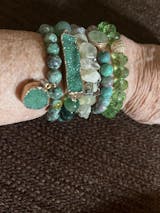Open a geode and you’ll see a miniature universe of glittering crystals, each one no bigger than a grain of sugar. That sparkling carpet is “druzy.” Put simply, what is druzy stone? It’s a surface of countless micro-crystals that have grown on top of another rock or mineral—quartz upon agate, quartz upon chalcedony, even tiny calcite atop a host stone. In jewelry, those micro-crystals act like a million tiny mirrors, giving you shine that reads luxe without tipping into loud.
How druzy grows—slow water, open space, patient time
Druzy is born from water and time. Mineral-rich water seeps into a pocket or cavity in rock. Inside that small, sheltered space, the water slows down and cools. As it does, dissolved silica or other minerals begin to crystallize on the inner walls. First, a few seed crystals appear. Then, layer by delicate layer, a fine crust of tightly packed points spreads across the surface. Think of frost forming on glass, but on a geological timetable. Over seasons and centuries, that glittering mat thickens, turning a plain cavity into a constellation.
Volcanic basalts with trapped gas bubbles, banded agates with hollow centers, and cracks along old mineral veins are ideal places for this quiet work to happen. That’s why you’ll often see druzy presented as thin “slices” or cabochons cut from the skin of a geode or from the inner lining of an agate nodule.
The look and the language—druzy quartz meaning in real life
Most jewelry druzy is quartz. Its color palette comes from trace minerals, the host stone, or later treatments, so you’ll encounter whites, greys, champagne, rose, and deep violets that pair beautifully with evening fabrics. The everyday meaning people attach to quartz druzy is straightforward: it’s a mood lifter. The sparkle is fine-grained and elegant, so it catches light like fresh snow under street lamps—festive, but controlled. That’s why it behaves so well in a stack: a little glamour, zero fuss.
If you love a violet palette, amethyst druzy marries texture with tone. For an instant party upgrade that still works with knitwear and denim, explore the druzy gemstone jewelry pieces in violet—an easy place to start is the Amethyst Druzy Stone Bracelet Set, which layers smooth rounds with a druzy focal. Hence, the shimmer feels intentional, not flashy.
Color: natural hues, enhancements, and how to read them
Nature gives druzy a subtle, mineral palette—icicle white, pewter grey, smoky champagne, mossy green, lilac to royal purple when the host is amethyst. Jewelers sometimes enhance or coat druzy to unlock bolder effects, from oil-slick metallics to candy brights. These can be beautiful; the key is knowing what you’re buying and choosing a finish that suits your wardrobe.
If your style leans classic, stay near nature: soft pinks, violets, and neutrals. If you like editorial drama, a coated or dyed slice can be the single “loud” note in an otherwise quiet outfit. Either way, a curated bracelet set keeps the look cohesive so the sparkle reads chic rather than costume.
Quality cues you can spot with the naked eye
Great druzy looks even and lively. You want a dense field of micro-points with minimal bald patches. Run a fingertip lightly over the surface; it should feel like velvet glitter, not jagged grit. In bracelets, inspect the edges of slices and the polish on any surrounding beads. Metal accents should be smooth, and stretch cords should slide without snags. In a well-edited stack, at least one bracelet will feature the druzy, while the others provide rhythm—slim, medium, statement—so the wrist tells one color story rather than five unrelated ones.
Natural vs treated, and the quick read on authenticity.
You’ll see two conversations in the market: natural druzy vs synthetic and natural vs treated. “Synthetic” can mean quartz grown in a lab and then textured, or a non-quartz material made to mimic the effect. Treated can mean dyed or coated natural druzy to achieve a specific color or sheen. There’s a place for both, especially when you’re shopping for a very particular palette or a gift under a specific budget. If you care about “nature-forward,” look for colors that make sense (champagne, grey, soft violet, gentle pink) and a crystal field that isn’t too perfectly uniform. If you want a bold, editorial look, a coated slice will give you mirror-like flash you won’t usually find in a purely natural piece.
Two practical tells help when you’re browsing online photos. First, edge color: if a slice is vividly saturated through the edge in a neon hue, it’s likely dyed. Second, sheen: an oil-spill metallic rainbow usually signals a titanium or similar coating. Neither is “bad”; it just helps you match the finish to your style on purpose.
Why druzy belongs in bracelet stacks
Stacks thrive on contrast. Smooth rounds provide calm; druzy contributes texture and sparkle. The effect is photograph-friendly in a way faceted glass alone isn’t—the little crystal points twinkle at every gesture. That’s why sparkle crystal bracelets with a druzy accent perform so well for holidays, birthdays, and nights out, yet still feel right at coffee with a cardigan. A single druzy piece in a five-bracelet set gives you the mood lift of sequins without committing to sequins.
If you want a sure bet, reach for a curated stack that already balances textures. Pair an amethyst-forward set that includes druzy with a neutral crystal set in champagne or clear. Worn together, you get light play plus color, and each piece remains easy to mix into outfits you already own.
How to style druzy from morning to midnight
Start with fabric. Druzy loves texture: cashmere, bouclé, nubby knits at 10 a.m.; silk, satin, and velvet after dark. In the daytime, keep your palette simple—lavender with oat, pewter with navy, champagne with cream—and let the druzy catch daylight in a low-key way. At night, add one more bracelet with a faceted crystal for extra gleam. If you wear a watch, place two slim bracelets between the watch and the druzy piece so the focal has a little breathing room.
Color pairing is equally easy. Violet druzy warms next to gold and deepens next to black; pink druzy feels candle-lit beside champagne crystal; neutral druzy is a friend to denim, camel coats, and ivory blouses. If you’re tempted by turquoise, let violet be the anchor and blue the accent for a confident, travel-ready mix.
Fit, comfort, and durability—what matters on the wrist
Comfort first. Stretch-cord construction means slip-on ease and a smooth drape. If you prefer a tailored look, wear three bracelets; for movement and glamour, wear five. When a stack includes a druzy slice, the setting should be low-profile enough that it won’t catch on knits. Roll bracelets on and off rather than pulling; treat them like the little treasures they are. Avoid heavy perfumes and long soaks, and give them a quick wipe with a soft cloth before storing in a pouch or tray.
Care myths, clarified.
Ultrasonic cleaners and abrasive jewelry dips are overkill for druzy. Gentleness is the rule. A little lukewarm water, a drop of mild soap, pat dry, done. If your piece includes coated or dyed material, keep it out of harsh sunlight when you’re not wearing it; that preserves color over the long arc of seasons.
How jewelers use druzy—slices, cabochons, and bead accents
Bracelet design plays with proportion. A slice bracelet gives you a single statement surface; chip strands add organic movement; a round-bead strand set with a tiny druzy charm gives you a wink of texture without dominating the stack. Cabochons (domed stones) with a druzy face are often set into bezels for a clean silhouette. In a five-bracelet stack, one druzy, one metallic accent, one faceted crystal, and two smooth stone strands is a formula that rarely misses.
If you prefer a ready-to-wear palette that nails those choices, look for a violet or pink-based set that includes a druzy focal, then add a neutral crystal set for versatility. That two-stack system lets you dial your shine up or down depending on the day.
Gift-giving: who loves druzy most?
The celebration-lover, for whom Saturdays come with a side of sparkling water and a glossy manicure. The minimalist who loves one special detail. The person is rebuilding a wardrobe around confidence and joy. Druzy’s micro-sparkle flatters all of them because it’s lively without being loud. If you’re writing a card, keep the message simple: “A little light for your wrist. Wear whenever you need a reminder to celebrate what’s already good.”
Quick ways to tell if a piece suits your closet
Look at your favorite three outfits. If two of them include knitwear or soft neutrals, choose champagne or violet druzy. If you live in black, pick pewter or deep purple to keep things sleek. If you reach for blue denim five days a week, let a lavender or soft pink druzy be your color accent. A stack should feel like it was waiting for your clothes to show up.
The takeaway—texture that earns its place
Druzy is the rare detail that feels special at first wear and keeps earning its spot. It gives natural sparkle, tells a story about time and patience, and plays beautifully with the jewelry you already own. Whether you start with a single slice or a full five-piece set, you’re inviting a little ceremony into ordinary mornings: roll on the bracelets, catch the light, step out the door with intention.
If you’re ready to bring that fine-grained shimmer into your rotation, begin with a curated bracelet stack that includes a druzy focal, then add a neutral crystal set so you can tune the shine to your day. That one-two approach turns the geology lesson inside your geode into something you can actually live in—quiet glitter, real craftsmanship, and a wrist that feels dressed without trying.







